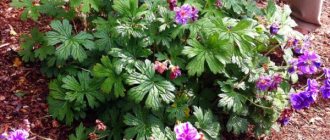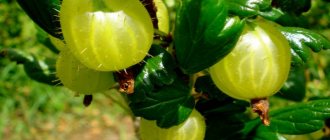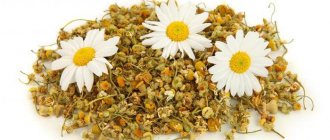Horizontal layering
This method of propagating gooseberries is perhaps one of the most reliable and effective. It is preferable to practice this method of gooseberry propagation in October.
In the spring you can also lay cuttings, but this must be done very early, even before the buds open and while there is still enough moisture in the ground (late March - mid-April).
We choose a healthy gooseberry bush, approximately 5-6 years old, take several well-developed branches aged from 1 to 3 years, which are lowest to the ground.
On the branches, first of all, we cut off annual growths by 1/3 of their length. This operation will promote better germination of lateral buds and the formation of strong shoots with well-developed roots.
Then, after pruning, we bend the branches to the ground and lay them in the grooves that we prepared in advance, and pin them tightly with metal or wooden hooks.
We fill the furrows with branches laid in them with fertile soil, water and mulch.
Next, don’t forget to periodically weed, water and feed. And soon the axillary buds on the branched branches begin to grow and vertically growing shoots form.
After the young shoots reach a length of 8-10 cm, they need to be hilled, and after two weeks the hilling is repeated.
At the end of September, we separate a branch with well-rooted shoots from the mother plant with pruning shears, dig it up and cut it based on the number of rooted shoots.
Then we sort them, shorten the roots, and cut the shoots to ¼ length. I recommend not to plant these shoots immediately in a permanent place, but to plant them for growing and in a year we will get excellent viable seedlings with 3-4 shoots and well-developed roots 30-50 cm long.
The main disadvantage of this method of reproduction is its high labor intensity. But at the same time, it is the most reliable when propagating European varieties.
Arc-shaped layering
In some varieties of gooseberries, thin arched shoots, touching the ground, quickly take root. In this case, rooting can take place without our help, but if we help the plant a little, this process will go faster.
Where the branch touches the ground, dig a hole, place the branch in it, pin it and cover it with humus soil, forming a small mound.
In the fall, we separate the rooted cuttings from the mother bush and dig it up. We carefully inspect the resulting seedlings and, depending on their condition, send them either for growing or immediately plant them in a permanent place.
This method is very simple and effective. Its only drawback is that only one seedling is produced per branch. But if you are not growing gooseberry seedlings for sale or are not planting large plantations of this plant, then this is quite enough to update your plantings.
How gooseberries reproduce by stem shoots
Gooseberries reproduce themselves by stem shoots. One-year-old branches produce buds from which roots are formed. If you sprinkle them with soil, the root system develops quickly. The advantage of this propagation method is that the stems of the seedlings are thick and strong, the plant grows easily and quickly.
You can remove the growth as follows:
- In spring, the soil around is loosened and fertilized with 5-7 cm of rotted manure.
- All old 2-3 year old branches are cut off, the cuts are treated with potassium permanganate and garden varnish. Active growth of young shoots begins.
- When young branches grow 10-15 cm, they are heavily sprinkled with earth at the base.
- In order for the shoots to bush, the top is pinched.
- By autumn, roots appear, but future seedlings are left until spring.
- In spring they are separated from the mother bush. Be sure to prune by 2-3 buds so that the plant develops a root system.
- Before planting in a permanent place of growth, they are grown for another year in a greenhouse. Replant together with a lump of earth.
Reproduction by stem shoots is similar to reproduction by vertical layering.
Lignified cuttings
Due to the fact that gooseberry cuttings take root rather poorly, many advise against cuttings, but I believe that this advice should be heeded by those involved in the industrial cultivation of seedlings.
And we, summer residents, can experiment and even if out of 10 cuttings we produce 2 or 3 roots, then this will be enough for us.
We prepare cuttings in early spring even before the buds wake up and begin to grow. And in the fall we cut the cuttings just before planting.
If we cut cuttings from the top of the shoots, they will take root and develop much better compared to those cuttings that are cut from the bottom of the shoots.
We plant cuttings cut in spring into open ground only after the soil has thawed to a sufficient depth. Before planting, cuttings can be stored at home in the refrigerator, after wrapping them in a damp cloth and placing them in a plastic bag.
Cuttings (20 cm long) cut in autumn are planted in a previously prepared bed with fertile soil. The distance between planted cuttings should be at least 15-20 cm.
It is best to plant cuttings at an angle of 45°, since with such planting we create more favorable conditions for the development of the cutting. After all, it is known that the higher the place where roots form in the cutting is located, the warmer the soil and the faster the rooting process will proceed.
After planting, thoroughly compact the soil around the cuttings, then water the plantings, only very carefully so as not to wash away the soil, and mulch with humus or peat in a layer of about 5-6 cm.
In the spring, when the snow melts, we will definitely check our seedlings. We carefully loosen the ground around them, level them, and if the cuttings are squeezed out of the ground, then we bury them back into the ground and press them lightly.
Later during the summer we carry out watering, loosening, weeding, and fertilizing.
Sowing seeds
When using this method, you need to take into account that the grown bushes may not have signs of the parent plant. Main stages of the process:
- Overripe gooseberries are collected, from which the seeds are removed, washed and dried.
- Prepare a container for seeding material: a drainage layer is placed on the bottom. Fertile soil is poured over the drainage (humus, sand and soil are mixed in equal parts).
- The seed material is laid out on the surface of the soil in increments of 4-5 cm and sprinkled with soil.
See also: Ripening time and rules for collecting gooseberries from a thorny bush
The containers are covered with film and placed in a room with a temperature of 3-5°C. Periodically, the shelter is removed and the soil is moistened. In spring, seedlings that have grown more than two leaves can be planted in open ground.
Green cuttings
The green cuttings method is a more effective way of propagating gooseberries than the previous one - using lignified cuttings. The best time for green cuttings of gooseberries is the second half of June. The rate of growth and development of shoots in plants largely depends on the weather, so the optimal timing of cuttings varies from year to year.
For cutting cuttings, it is best to use young growths of the current year, which are recommended to be harvested early in the morning or in the afternoon, or in cloudy weather.
The length of the cuttings should be approximately 7-12 cm, and they should be cut with a sharp knife or sharp razor. It is advisable to treat the cut cuttings with some kind of growth regulator for better rooting. To do this, dip the cuttings into the working solution and keep them for 12-24 hours at a temperature of 20-24°C.
Then we wash the sections treated in this way with running water and plant the cuttings in a specially prepared nursery according to the following scheme - 3x7 cm to a depth of 1.5-2 cm and carefully water them.
We prepare the soil in the nursery in advance: the top layer is from a mixture of peat or humus with sand or perlite (1:1); Below is a fertile layer, the thickness of which should be approximately 10 cm, made of rotted manure; the lowest layer is drainage, since gooseberries do not like waterlogging.
It is very important to create the most favorable conditions for seedlings to take root, namely: warmth and high levels of air humidity. Thus, the most optimal air temperature is considered to be 18-23°C, and the night temperature should not fall below 16-21°C. It is recommended to water the seedlings only with warm water.
At the same time, overheating should not be allowed, so on very warm sunny days the nursery should be opened slightly, and the top should also be shaded with some kind of fabric or covering material.
After the roots have formed, it is necessary to regularly weed the plantings and loosen the soil. You can feed our seedlings several times over the summer with a solution of slurry diluted 6 times (½ bucket per 1 m2) or urea (20-30 g per 1 m2).
If at the very beginning of root formation it is necessary to maintain a high level of humidity (there should be moisture on the leaves), then after mass rooting we reduce the humidity level to 70-85%, and then bring it to humidity in open ground.
Further care
After rooting the cuttings in the summer, it is important to properly care for them. For moisture-loving gooseberries, it is advisable to install an aeration system, especially during a dry period.
Watering is carried out as the upper layers of the soil dry out. Each young bush requires 3 to 5 liters of water.
In order for the root system to successfully form, on the 3rd day after transfer to open ground, the cuttings are watered with succinic acid (for 1 plant - 0.2 g of dry matter and 1 liter of water). After 2 weeks, complex fertilizers are applied.
Combined cuttings
A combined cutting is a green shoot with part of last year's lignified growth, the length of which should not exceed 3-4 cm. We prepare cuttings with a heel, a crutch, and a stand.
We get a cutting with a heel when we simply break out a branch; cutting with a stalk - this is when we cut off a green branch with part of the woody shoot and the cut goes along last year’s brown growth; We prepare a cutting with a stand from a side branch and it turns out that part of the woody shoot (crutch) extends perpendicularly from the green branch.
You can start propagating gooseberries in this way from the end of May, as soon as the green growths reach a height of 5-7 cm, and then for almost the entire active growing season.
We plant the prepared cuttings in loose, well-moistened soil, deepening the “heel” and base by 3-4 cm. Then we water and mulch the soil abundantly. Roots most often form within one and a half to two weeks.
The best time to propagate gooseberries
Both spring and autumn are suitable for gooseberry propagation. This mainly depends on the method chosen.
I want to save the best gooseberry bushes, but even anti-aging pruning cannot extend the productive period indefinitely, so you will have to use one of the methods of propagating the plant
Layers from the bush are taken in early spring. The procedure can be combined with regular pruning. It is important to do it before the plant begins its active growing season. If the leaf buds have turned into green “cones” or even opened up, it’s already too late. They should only swell slightly. They are also planted quite early. You need to wait until the soil has completely thawed at a depth of 8–10 cm, this is quite enough. In regions with a temperate climate, this usually occurs in mid-April or early May. There are also reliable folk signs that you can easily rely on - leaves blooming on birch trees or dandelions beginning to bloom.
Green cuttings are planted in the ground throughout June, lignified ones - in mid-October. In the first case, there is no need to prepare planting material in advance. You can cut them on the same day or a day or two before the intended planting.
Dividing the bush can be done in both spring and autumn. The main thing is that its parts have time to take root in the new place. Therefore, the period from late August to early October is quite suitable for warm southern regions. There, winter, as a rule, comes in accordance with the calendar, so you can be more or less sure that there are at least two months left before the first frost. To divide the bush in the fall, you must wait until the leaves fall. A plant that has fallen into hibernation will undergo the procedure less painfully.
In spring, gooseberry bushes are divided in regions with a temperate climate. Over the summer, they manage to adapt to new living conditions and properly prepare for winter. In this case, you need to catch it before the buds swell. A bush that is not completely “awakened” reacts to the procedure much less painfully.
Perennial branches
Old gooseberry branches cut out in spring or autumn can not be thrown away, but used for propagation.
To do this, we dig a hole in the ground, place a branch there and cover it with fertile soil. On the surface we leave only the very top of the branch and this year’s green growth. To stimulate the awakening of lateral buds, green growths can be pinched.
In the future, the soil must be constantly kept moist. We begin to feed the shoots when they begin to grow. Then in the fall we dig up the branch, divide it into separate seedlings, depending on how many shoots have taken root, and plant them in a separate bed for growing.
Dividing the bush
This propagation method is usually used in cases where it is necessary to transplant a valuable variety from an old site to a new one.
A year before the planned transplant, it is necessary to cut out all the old branches at the root so that new shoots begin to grow.
Next year we dig up the bush, divide it into several parts and immediately plant them in pre-prepared planting holes. It is best to do such a transplant either in the fall or in the spring, but not in the summer.
Well, dear readers, we briefly examined all the methods of propagating gooseberries. I hope that in this article you will find useful information that will help you successfully propagate your favorite variety, and we’ll talk about gooseberry diseases and pests in the following articles.
In conclusion, I would like to invite you to take a little break from the propagation process and watch an interesting video on how to make gooseberry ice cream.
See you soon, dear readers!
Features of culture propagation
Summer residents love gooseberries for their easy care, quick survival after transplantation, and high productivity. There are many ways to propagate gooseberries in spring, summer or autumn and get the variety or hybrid you like without much hassle.
Planting material at the dacha:
- layering;
- cuttings (green and already woody);
- seeds.
Dividing a bush is popular, especially when it is necessary to rejuvenate an old plant. In any case, the following characteristics are taken into account:
- age of the bush;
- absence of disease;
- high yields.
It is believed that European varieties of crops are better propagated by layering, and hybrids by cuttings. The seed method is labor-intensive; it is usually used to obtain new varieties at breeding stations and nurseries. If desired, at home, gardeners can experiment by growing a bush from seeds.
It is important to correctly identify suitable plants from which to take cuttings or shoots. Only strong, healthy and productive bushes are suitable, without deformations and not affected by pests and diseases. If gooseberries of an unknown variety are grown on the site, then it is better and more reliable to propagate it by layering.











